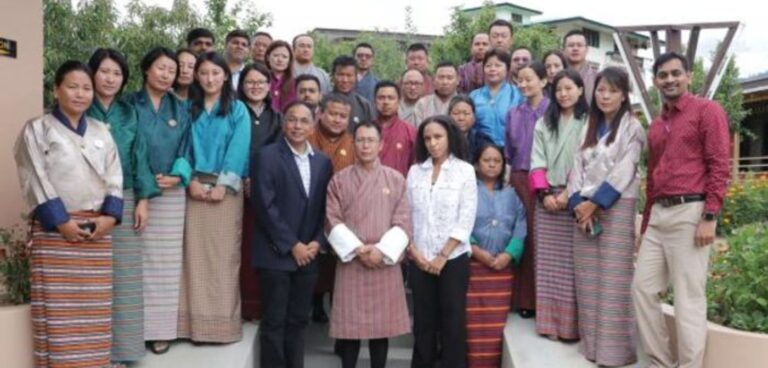The World Meteorological Organization (WMO) has implemented a project to strengthen the capacity to provide climate services and support climate-sensitive sectors in the remote, landlocked mountainous country Bhutan.
The Climate Services Information System (CSIS) is the principal mechanism through which information about climate – past, present and future – is routinely archived, analyzed, modeled, exchanged and processed. CSIS is designed to produce and authoritatively deliver climate information data and products through appropriate operational mechanisms, data exchange and technical standards.
To enable Bhutan’s meteorological and hydrological service to produce, communicate and apply climate information products efficiently, the project deployed a customized Climate Services Toolkit (CST). This consisted of a suite of guidance, data, software tools, training resources and examples (case studies) for enabling climate services. In particular, the climate targeted services included: climate data rescue, management and mining; climate analysis and monitoring; climate prediction; climate projection; and tailoring information to specific user needs. It includes products, tools, models and data from Regional Climate Centres (RCCs) and WMO Global Producing Centres for Long-Range Forecasts.
Karma Dupchu, director of the national meteorological and hydrological service and permanent representative of Bhutan with WMO, said, “All the sectors need climate information and services for planning and decision-making, especially in the light of climate variability and climate change. Access to information and services is a great challenge for many developing countries. The Climate Service Toolkit is a platform for the NMHS where a wide range of sectors can avail climate information, products and services.”
Dr Filipe Lucio, director of member services and development department at WMO, noted, “Advancing the development of effective climate services to assist decision and policy-making application, particularly in adaptation practice and planning, will require a strong engagement between users and providers of such services and effective mechanisms facilitating access to climate information. The Climate Services Toolkit is a central enabling piece for the implementation of the Climate Services Information System, which forms the primary mechanism established by the Global Framework for Climate Services (GFCS) for producing and delivering authoritative climate information and services. The current project on developing capacities for effective climate services in Bhutan sets a critical landmark in the WMO strategy for deployment and application of Climate Services Toolkit worldwide.”
As a first step to improving the climate services capacities, a stock-taking exercise was carried out to identify and understand the existing capacities, gaps and requirements. After consultations through online surveys, the agriculture, water and health sectors were selected for the development of tailored climate information and products. A roadmap was developed and outlined the following requirement for the sector users: integration of sub-seasonal to seasonal forecast for sector users; climate indices and access to regional and global reanalysis data; and capacity building of the national meteorological and hydrological service and sector users.
Dr G Srinivasan, chief scientist of climate applications with Regional Integrated Multi-Hazard Early Warning Systems in Asia and Africa (RIMES), said, “Climate information enables effective management of climate risks in key sectors and the WMO Climate Services Toolkit (CST) Bhutan has contributed to this effort. Leveraging appropriate tools developed through close interaction with user departments like agriculture and water, the project has made the access and provisioning of climate services in Bhutan.”
To test the customized CST at a local level, two Dzongkhags (districts), namely Paro and Wangdue, were identified as pilots. The Dzongkhag Level Climate Information Services Forum (CISF) will increase the awareness of climate products and services delivered for planning and decision-making at the local level. It will further improve the knowledge and understanding of climate hazards and their impacts on the sectors while promoting the co-production of climate services at a local level for sector-specific application.
The Dzongkhag level CISF will link to the National Climate Outlook Forum (NCOF), which is held annually by the NCHM before the onset of the southwest monsoon, and target the local government officials, village representatives, block agriculture extension officials and representatives from the relevant departments/stakeholders.
The two-year project, titled ‘Developing capacities for effective climate services in Bhutan’ was carried out with support from the National Centre for Hydrology and Meteorology (NCHM) Bhutan and the Regional Integrated Multi-Hazard Early Warning Systems in Asia and Africa. It was funded by the Korea Meteorological Administration (KMA) through the Korea Global Framework for Climate Services (GFCS) trust fund to support the implementation of GFCS at the national scale and promote the planning and implementation of climate adaptation measures in climate-sensitive sectors.
According to the organization, the deployment of the climate services toolkit in Bhutan is the first such instance where WMO has made the system operational. The experience gained from Bhutan will therefore pave the way for future implementation of CST around the world and help members to deliver climate information effectively to its users.
The organization pointed out that effective climate services are essential to support agriculture, water, health and other sectors, to develop and evaluate climate adaptation strategies. For example, climate services can empower farmers to select the appropriate crops and marketing strategies based on seasonal climate forecasts; assist public health services to target vaccines and other prevention campaigns to limit climate-related disease outbreaks; and help improve the management of water resources and energy.
The operationalization of the climate services toolkit through the project is expected to improve the delivery of climate services in Bhutan. To sustain the project, it will be critical to monitor and evaluate the socioeconomic benefits of these climate services, improve observation networks and database systems, strengthen human resources capacities and promote research in climate science, modeling and prediction. Upcoming projects and initiatives in the region can help strengthen these aspects and promote collaboration not just at the national level but at the regional and global level as well.



